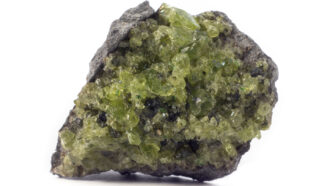
Cocooned within the bowels of the Earth, one mineral’s metamorphosis into another may trigger some of the deepest earthquakes ever detected.
These cryptic tremors — known as deep-focus earthquakes — are a seismic conundrum. They violently rupture at depths greater than 300 kilometers, where intense temperatures and pressures are thought to force rocks to flow smoothly. Now, experiments suggest that those same hellish conditions might also sometimes transform olivine — the primary mineral in Earth’s mantle — into the mineral wadsleyite. This mineral switch-up can destabilize the surrounding rock, enabling earthquakes at otherwise impossible depths, mineral physicist Tomohiro Ohuchi and colleagues report September 15 in Nature Communications.
“It’s been a real puzzle for many scientists because earthquakes shouldn’t occur deeper than 300 kilometers,” says Ohuchi, of Ehime University in Matsuyama, Japan.
Deep-focus earthquakes usually occur at subduction zones where tectonic plates made of oceanic crust — rich in olivine — plunge toward the mantle (SN: 1/13/21). Since the quakes’ seismic waves lose strength during their long ascent to the surface, they aren’t typically dangerous. But that doesn’t mean the quakes aren’t sometimes powerful. In 2013, a magnitude 8.3 deep-focus quake struck around 609 kilometers below the Sea of Okhotsk, just off Russia’s eastern coast.
Past studies hinted that unstable olivine crystals could spawn deep quakes. But those studies tested other minerals that were similar in composition to olivine but deform at lower pressures, Ohuchi says, or the experiments didn’t strain samples enough to form faults.
He and his team decided to put olivine itself to the test. To replicate conditions deep underground, the researchers heated and squeezed olivine crystals up to nearly 1100° Celsius and 17 gigapascals. Then the team used a mechanical press to further compress the olivine slowly and monitored the deformation.
From 11 to 17 gigapascals and about 800° to 900° C, the olivine recrystallized into thin layers containing new wadsleyite and smaller olivine grains. The researchers also found tiny faults and recorded bursts of sound waves — indicative of miniature earthquakes. Along subducting tectonic plates, many of these thin layers grow and link to form weak regions in the rock, upon which faults and earthquakes can initiate, the researchers suggest.
“The transformation really wreaks havoc with the [rock’s] mechanical stability,” says geophysicist Pamela Burnley of the University of Nevada, Las Vegas, who was not involved in the research. The findings help confirm that olivine transformations are enabling deep-focus earthquakes, she says.
Next, Ohuchi’s team plans to experiment on olivine at even higher pressures to gain insights into the mineral’s deformation at greater depths.

 A new treatment could restore some mobility in people paralyzed by strokes
A new treatment could restore some mobility in people paralyzed by strokes  What has Perseverance found in two years on Mars?
What has Perseverance found in two years on Mars?  This robot automatically tucks its limbs to squeeze through spaces
This robot automatically tucks its limbs to squeeze through spaces  Greta Thunberg’s new book urges the world to take climate action now
Greta Thunberg’s new book urges the world to take climate action now  Glassy eyes may help young crustaceans hide from predators in plain sight
Glassy eyes may help young crustaceans hide from predators in plain sight  A chemical imbalance doesn’t explain depression. So what does?
A chemical imbalance doesn’t explain depression. So what does?